Abstract
Exposure to elemental mercury (Hg) vapour results in an accumulation of Hg in the pituitary, the thyroid, and the testis. In this study, basal serum concentrations of pituitary hormones (thyrotrophin (TSH), prolactin (PRL), follicle stimulating hormone (FSH), and luteinising hormone (LH] or their response after administration of thyrotrophin and gonadotrophin releasing hormones did not differ between 11 male workers (mean urinary Hg (U Hg) concentration 26 nmol/mmol creatinine) and nine male dentists (U Hg concentration 1.3 nmol/mmol creatinine) exposed to elemental Hg vapour when compared with matched referent groups (U Hg concentration 0.6 and 0.4 nmol/mmol creatinine). Thus there was no evidence of an effect of Hg on the pituitary. Neither was there any association between exposure to Hg and serum concentrations of free thyroid hormones (S FT3, S FT4), testosterone, or cortisol. Increased plasma concentrations of selenium (Se) were associated with increased basal serum concentrations of TSH, decreased concentrations of basal serum cortisol, and decreased release of FSH.
Full text
PDF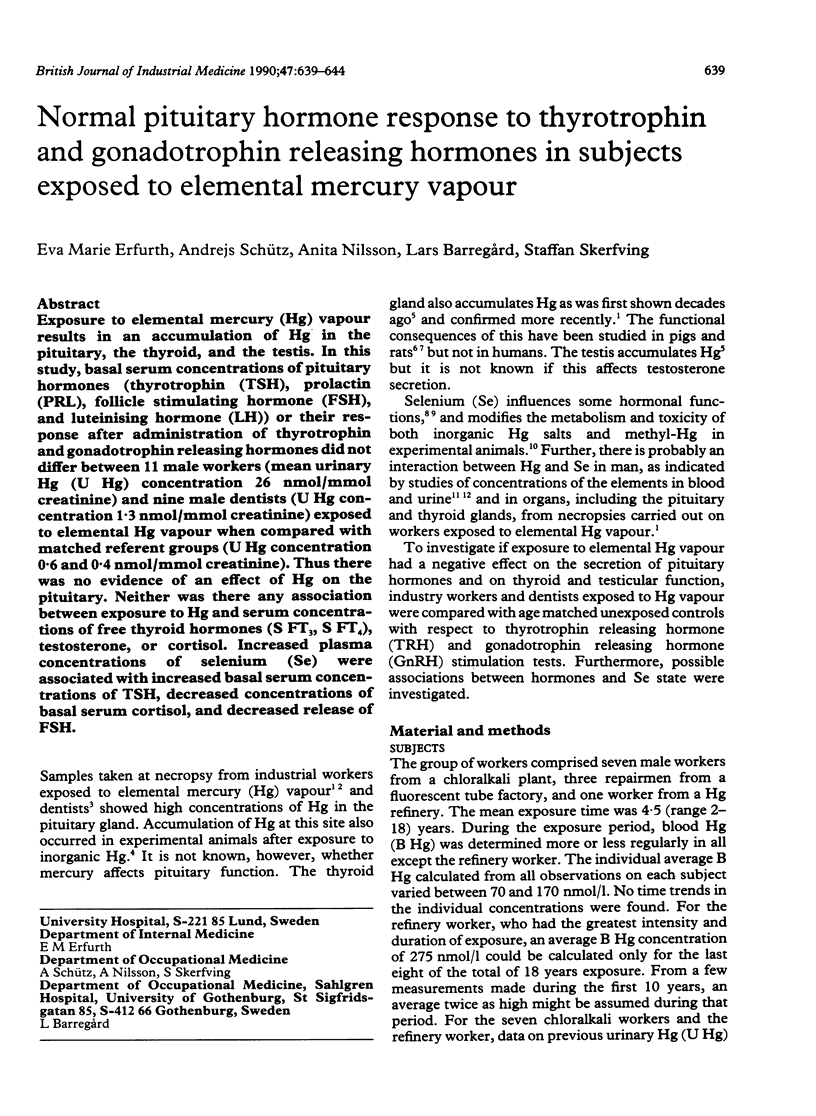
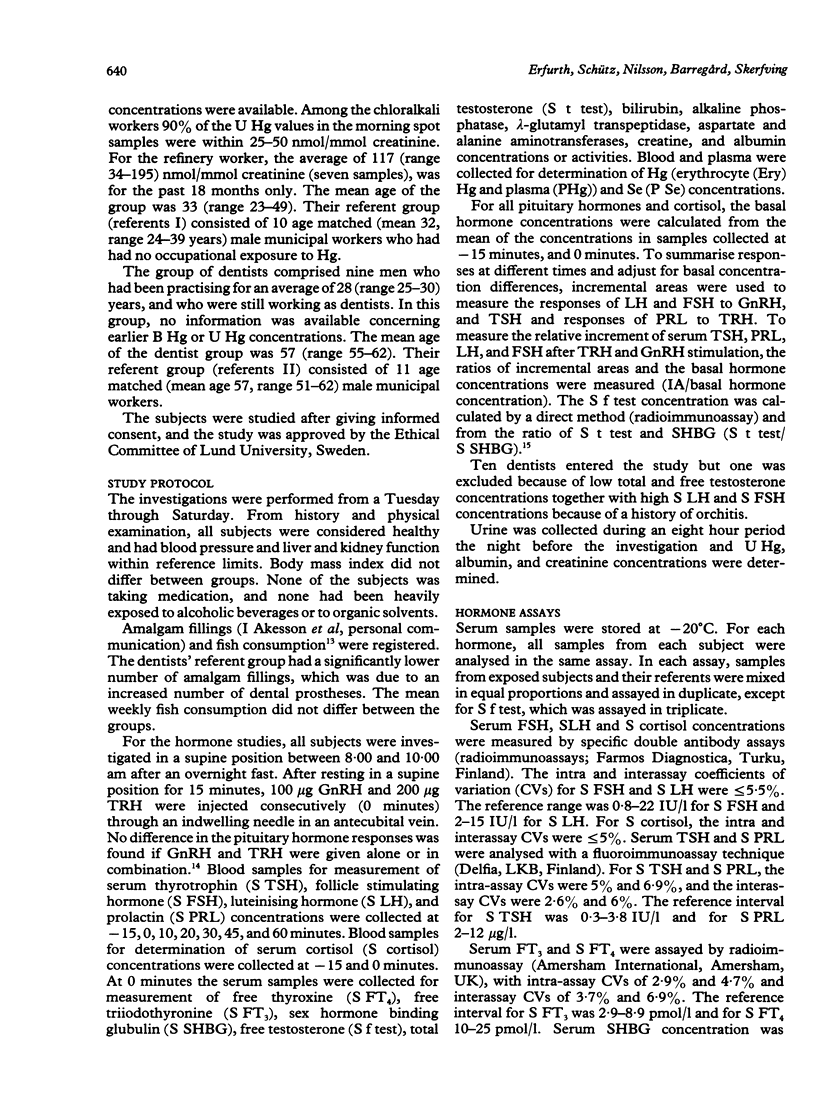
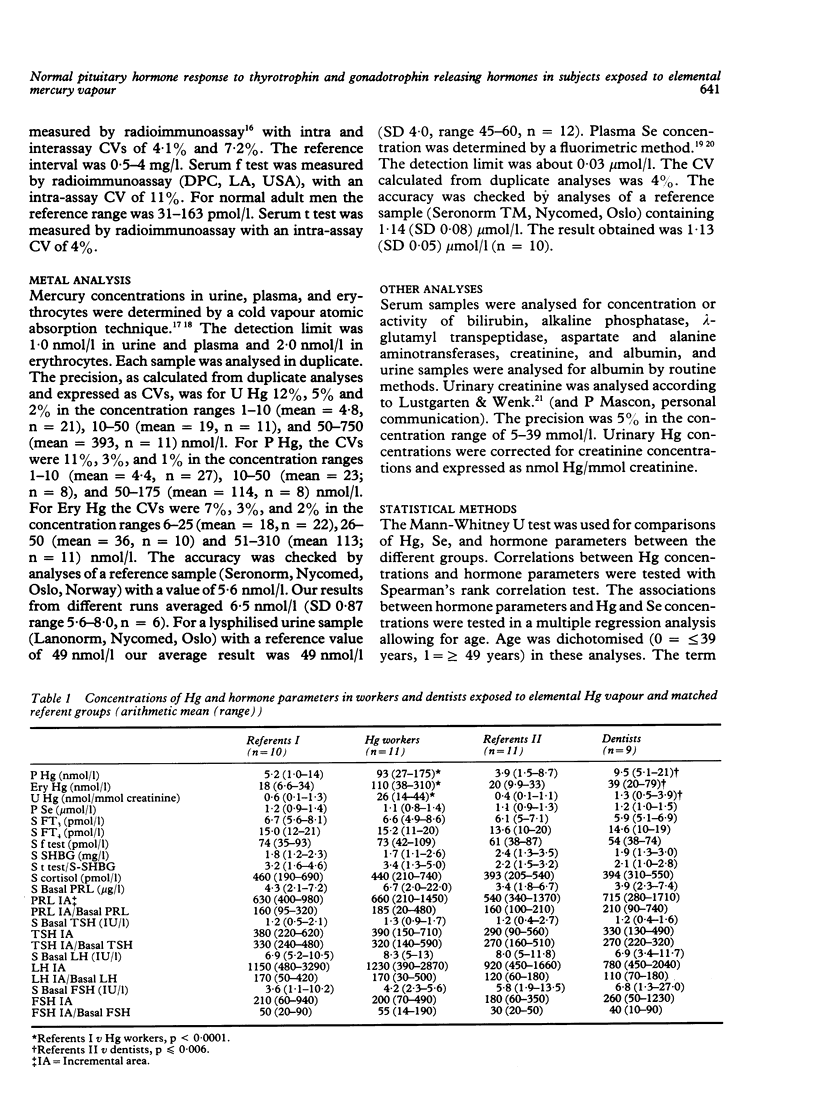
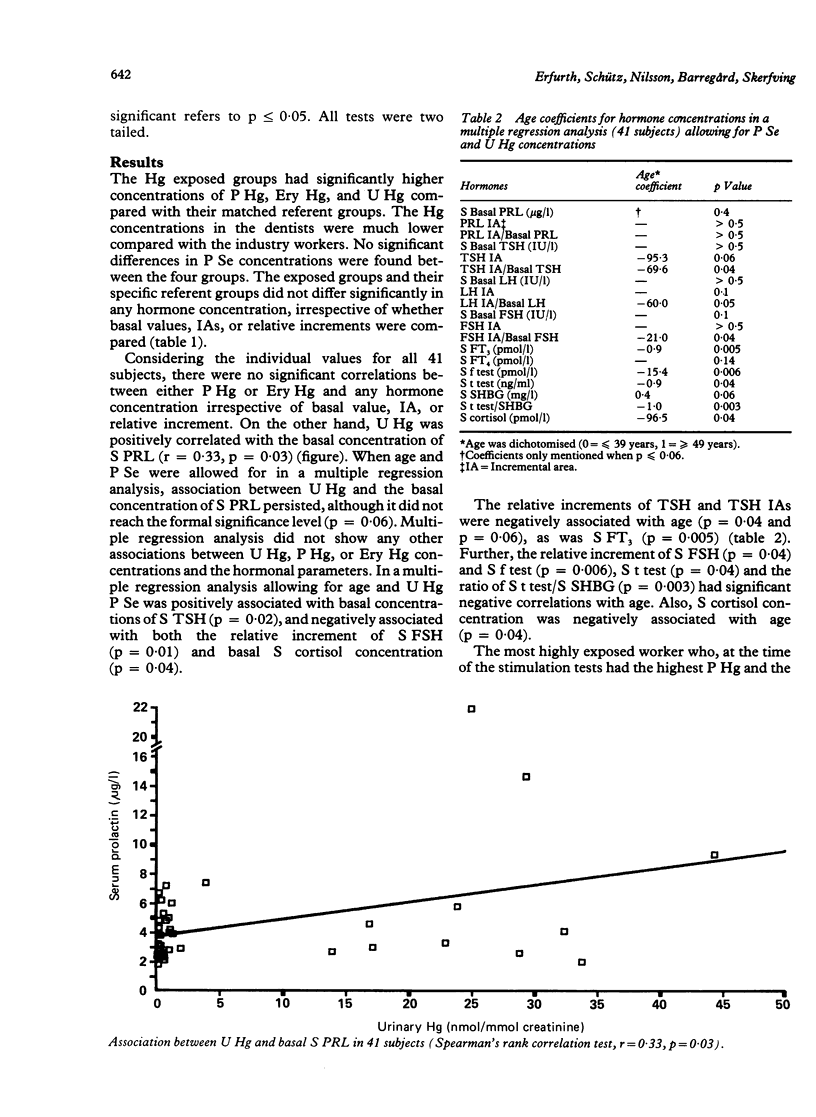
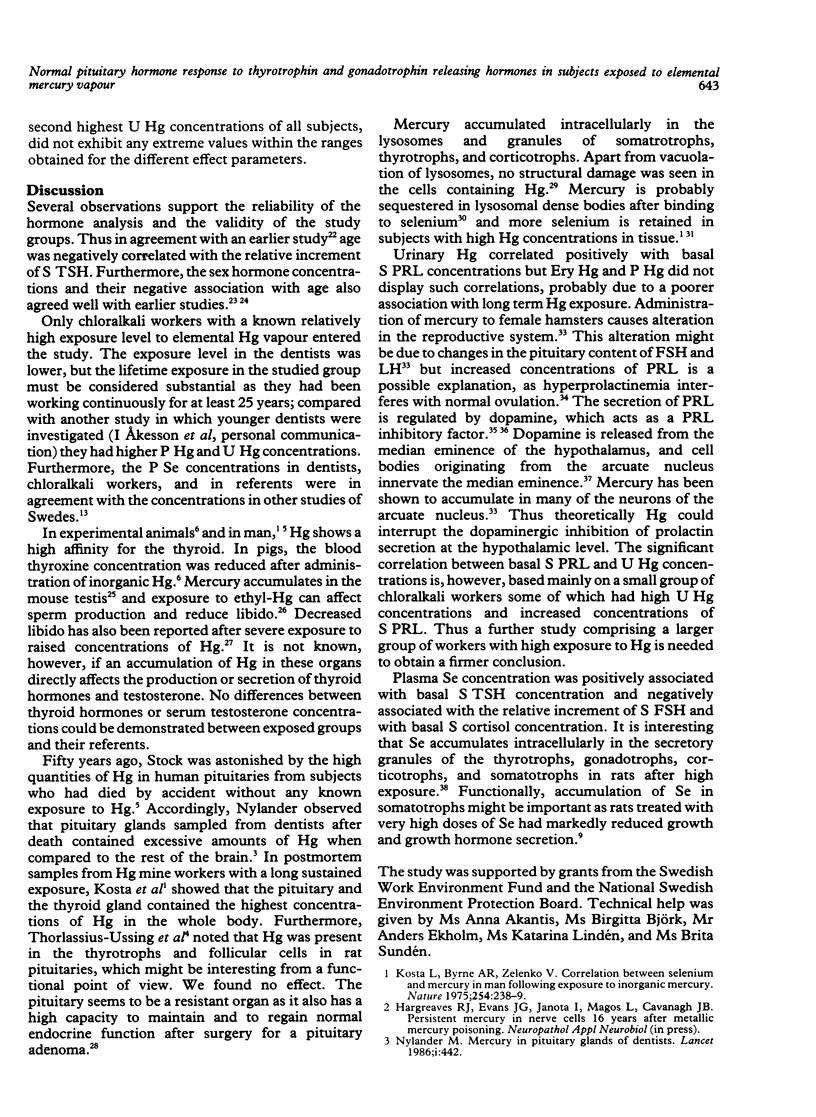
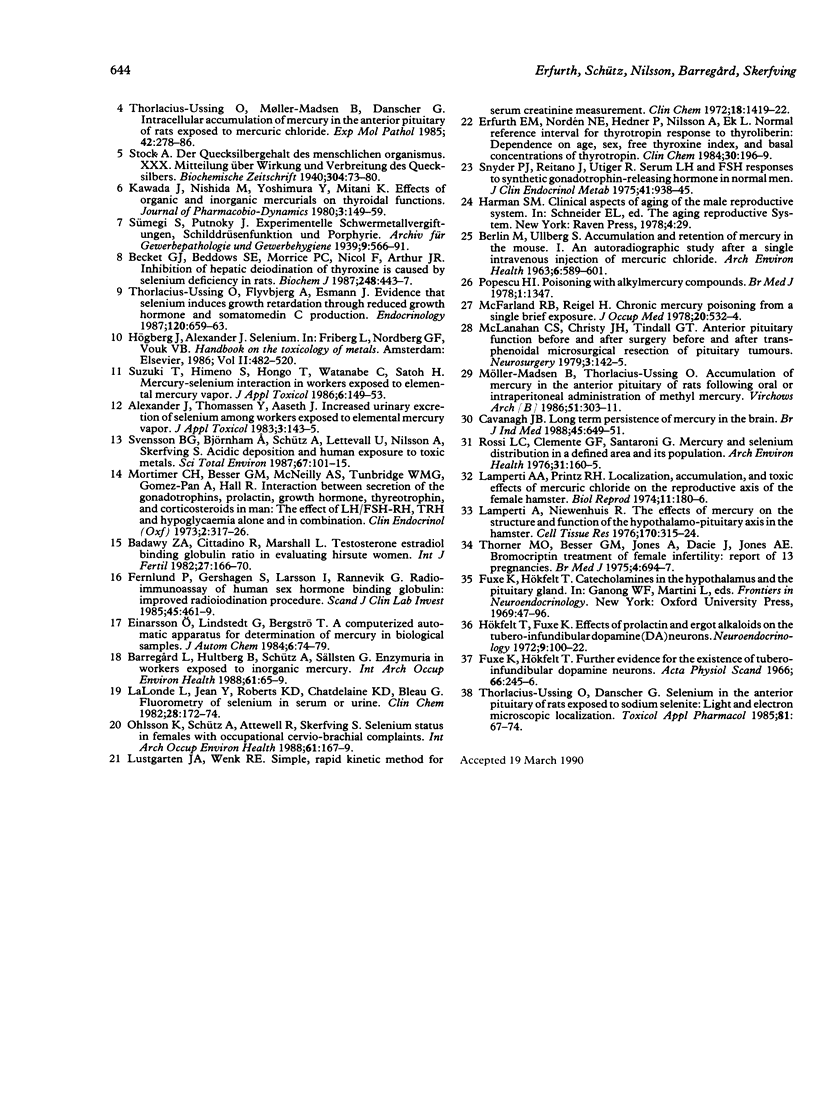
Selected References
These references are in PubMed. This may not be the complete list of references from this article.
- Alexander J., Thomassen Y., Aaseth J. Increased urinary excretion of selenium among workers exposed to elemental mercury vapor. J Appl Toxicol. 1983 Jun;3(3):143–145. doi: 10.1002/jat.2550030308. [DOI] [PubMed] [Google Scholar]
- BERLIN M., ULLBERG S. Accumulation and retention of mercury in the mouse. I. An autoradiographic study after a single intravenous injection of mercuric chloride. Arch Environ Health. 1963 May;6:589–601. doi: 10.1080/00039896.1963.10663447. [DOI] [PubMed] [Google Scholar]
- Badawy S. Z., Cittadino R., Marshall L. Testosterone : testosterone estradiol binding globulin ratio in evaluating hirsute women. Int J Fertil. 1982;27(3):166–170. [PubMed] [Google Scholar]
- Barregård L., Hultberg B., Schütz A., Sällsten G. Enzymuria in workers exposed to inorganic mercury. Int Arch Occup Environ Health. 1988;61(1-2):65–69. doi: 10.1007/BF00381609. [DOI] [PubMed] [Google Scholar]
- Beckett G. J., Beddows S. E., Morrice P. C., Nicol F., Arthur J. R. Inhibition of hepatic deiodination of thyroxine is caused by selenium deficiency in rats. Biochem J. 1987 Dec 1;248(2):443–447. doi: 10.1042/bj2480443. [DOI] [PMC free article] [PubMed] [Google Scholar]
- Cavanagh J. B. Long term persistence of mercury in the brain. Br J Ind Med. 1988 Oct;45(10):649–651. doi: 10.1136/oem.45.10.649. [DOI] [PMC free article] [PubMed] [Google Scholar]
- Erfurth E. M., Nordén N. E., Hedner P., Nilsson A., Ek L. Normal reference interval for thyrotropin response to thyroliberin: dependence on age, sex, free thyroxin index, and basal concentrations of thyrotropin. Clin Chem. 1984 Feb;30(2):196–199. [PubMed] [Google Scholar]
- Fernlund P., Gershagen S., Larsson I., Rannevik G. Radioimmunoassay of human sex hormone binding globulin: improved radioiodination procedure. Scand J Clin Lab Invest. 1985 Sep;45(5):461–469. doi: 10.3109/00365518509155244. [DOI] [PubMed] [Google Scholar]
- Fuxe K., Hökfelt T. Further evidence for the existence of tubero-infundibular dopamine neurons. Acta Physiol Scand. 1966 Jan-Feb;66(1):245–246. doi: 10.1111/j.1748-1716.1966.tb03192.x. [DOI] [PubMed] [Google Scholar]
- Hökfelt T., Fuxe K. Effects of prolactin and ergot alkaloids on the tubero-infundibular dopamine (DA) neurons. Neuroendocrinology. 1972;9(2):100–122. doi: 10.1159/000122042. [DOI] [PubMed] [Google Scholar]
- Kawada J., Nishida M., Yoshimura Y., Mitani K. Effects of organic and inorganic mercurials on thyroidal functions. J Pharmacobiodyn. 1980 Mar;3(3):149–159. doi: 10.1248/bpb1978.3.149. [DOI] [PubMed] [Google Scholar]
- Kosta L., Byrne A. R., Zelenko V. Correlation between selenium and mercury in man following exposure to inorganic mercury. Nature. 1975 Mar 20;254(5497):238–239. doi: 10.1038/254238a0. [DOI] [PubMed] [Google Scholar]
- Lalonde L., Jean Y., Roberts K. D., Chapdelaine A., Bleau G. Fluorometry of selenium in serum or urine. Clin Chem. 1982 Jan;28(1):172–174. [PubMed] [Google Scholar]
- Lamperti A. A., Printz R. H. Localization, accumulation, and toxic effects of mercuric chloride on the reproductive axis of the female hamster. Biol Reprod. 1974 Sep;11(2):180–186. doi: 10.1095/biolreprod11.2.180. [DOI] [PubMed] [Google Scholar]
- Lamperti A., Niewenhuis R. The effects of mercury on the structure and function of the hypothalamo-pituitary axis in the hamster. Cell Tissue Res. 1976 Jul 30;170(3):315–324. doi: 10.1007/BF00219414. [DOI] [PubMed] [Google Scholar]
- Lustgarten J. A., Wenk R. E. Simple, rapid, kinetic method for serum creatinine measurement. Clin Chem. 1972 Nov;18(11):1419–1422. [PubMed] [Google Scholar]
- McFarland R. B., Reigel H. Chronic mercury poisoning from a single brief exposure. J Occup Med. 1978 Aug;20(8):532–534. doi: 10.1097/00043764-197808000-00003. [DOI] [PubMed] [Google Scholar]
- McLanaham C. S., Christy J. H., Tindall G. T. Anterior pituitary function before and after trans-sphenoidal microsurgical resection of pituitary tumors. Neurosurgery. 1978 Sep-Oct;3(2):142–145. doi: 10.1227/00006123-197809000-00002. [DOI] [PubMed] [Google Scholar]
- Mortimer C. H., Besser G. M., McNeilly A. S., Tunbridge W. M., Gomez-Pan A., Hall R. Interaction between secretion of the gonadotrophins, prolactin, growth hormone, thyrotrophin and corticosteroids in man: the effects of LH FSH-RH, TRH and hypoglycaemia alone and in combination. Clin Endocrinol (Oxf) 1973 Oct;2(4):317–326. doi: 10.1111/j.1365-2265.1973.tb01717.x. [DOI] [PubMed] [Google Scholar]
- Møller-Madsen B., Thorlacius-Ussing O. Accumulation of mercury in the anterior pituitary of rats following oral or intraperitoneal administration of methyl mercury. Virchows Arch B Cell Pathol Incl Mol Pathol. 1986;51(4):303–311. doi: 10.1007/BF02899039. [DOI] [PubMed] [Google Scholar]
- Ohlsson K., Schütz A., Attewell R., Skerfving S. Selenium status in females with occupational cervico-brachial complaints. Int Arch Occup Environ Health. 1988;61(3):167–169. doi: 10.1007/BF00381014. [DOI] [PubMed] [Google Scholar]
- Popescu H. I. Poisoning with alkylmercury compounds. Br Med J. 1978 May 20;1(6123):1347–1347. doi: 10.1136/bmj.1.6123.1347-a. [DOI] [PMC free article] [PubMed] [Google Scholar]
- Rossi L. C., Clemente G. F., Santaroni G. Mercury and selenium distribution in a defined area and in its population. Arch Environ Health. 1976 May-Jun;31(3):160–165. doi: 10.1080/00039896.1976.10667211. [DOI] [PubMed] [Google Scholar]
- Snyder P. J., Reitano J. F., Utiger R. D. Serum LH and FSH responses to synthetic gonadotropin-releasing hormone in normal men. J Clin Endocrinol Metab. 1975 Nov;41(5):938–945. doi: 10.1210/jcem-41-5-938. [DOI] [PubMed] [Google Scholar]
- Suzuki T., Himeno S., Hongo T., Watanabe C., Satoh H. Mercury-selenium interaction in workers exposed to elemental mercury vapor. J Appl Toxicol. 1986 Jun;6(3):149–153. doi: 10.1002/jat.2550060303. [DOI] [PubMed] [Google Scholar]
- Svensson B. G., Björnham A., Schütz A., Lettevall U., Nilsson A., Skerfving S. Acidic deposition and human exposure to toxic metals. Sci Total Environ. 1987 Dec;67(2-3):101–115. doi: 10.1016/0048-9697(87)90204-x. [DOI] [PubMed] [Google Scholar]
- Thorlacius-Ussing O., Danscher G. Selenium in the anterior pituitary of rats exposed to sodium selenite: light and electron microscopic localization. Toxicol Appl Pharmacol. 1985 Oct;81(1):67–74. doi: 10.1016/0041-008x(85)90121-8. [DOI] [PubMed] [Google Scholar]
- Thorlacius-Ussing O., Flyvbjerg A., Esmann J. Evidence that selenium induces growth retardation through reduced growth hormone and somatomedin C production. Endocrinology. 1987 Feb;120(2):659–663. doi: 10.1210/endo-120-2-659. [DOI] [PubMed] [Google Scholar]
- Thorlacius-Ussing O., Møller-Madsen B., Danscher G. Intracellular accumulation of mercury in the anterior pituitary of rats exposed to mercuric chloride. Exp Mol Pathol. 1985 Apr;42(2):278–286. doi: 10.1016/0014-4800(85)90034-6. [DOI] [PubMed] [Google Scholar]
- Thorner M. O., Besser G. M., Jones A., Dacie J., Jones A. E. Bromocriptine treatment of female infertility: report of 13 pregnancies. Br Med J. 1975 Dec 20;4(5998):694–697. doi: 10.1136/bmj.4.5998.694. [DOI] [PMC free article] [PubMed] [Google Scholar]


